The EVGA GeForce GTX 1070 Ti FTW2 Review: iCX Brings the Lights and Sensors
by Nate Oh on January 31, 2018 9:00 AM EST- Posted in
- GPUs
- EVGA
- GeForce
- NVIDIA
- GTX 1070 Ti
Power, Temperature, & Noise
As expected given the NVIDIA-standardized GTX 1070 Ti clocks, the standard benchmarks for the GTX 1070 Ti FTW2 were rather humdrum in terms of raw performance, sticking closely to the reference Founders Edition card. Nevertheless, the FTW2's custom features certainly come into play for power, temperature, and noise, factors not to be underrated especially when compared against typically louder and hotter reference blower models. Generally speaking, modern GPU boost technology will typically take advantage of a board’s better power and temperature characteristics for longer and higher boosts, but with mandated reference clockspeeds the GTX 1070 Ti FTW2 simply operates cooler and quieter.
| GeForce Video Card Average Clockspeeds | ||||
| Game | EVGA GTX 1070 Ti FTW2 | GTX 1070 Ti | GTX 1070 | |
| Max Boost Clock |
1898MHz
|
1898MHz
|
1898MHz
|
|
| Battlefield 1 | 1860MHz |
1826MHz
|
1797MHz
|
|
| Ashes: Escalation | 1850MHz |
1838MHz
|
1796MHz
|
|
| DOOM | 1847MHz |
1856MHz
|
1780MHz
|
|
| Ghost Recon Wildlands | 1860MHz |
1840MHz
|
1807MHz
|
|
| Dawn of War III | 1860MHz |
1848MHz
|
1807MHz
|
|
| Deus Ex: Mankind Divided | 1855MHz |
1860MHz
|
1803MHz
|
|
| Grand Theft Auto V | 1862MHz |
1865MHz
|
1839MHz
|
|
| F1 2016 | 1860MHz |
1840MHz
|
1825MHz
|
|
| Total War: Warhammer | 1855MHz |
1832MHz
|
1785MHz
|
|
Though it does appear that the GTX 1070 Ti boosts a little higher and more consistently, there’s little change for the out-of-the-box GTX 1070 Ti FTW2 performance compared to the Founders Edition. For the majority of the standard benchmarks, the difference was within the margin of error.
As for power, the GTX 1070 Ti FTW2’s extra capabilities are rather muted at stock. At idle, the board turns off the fans under certain temperatures – the default master BIOS has a 60 degree threshold – and technically speaking, the LEDs pull some power, but total system consumption rarely reflects such small differences and adjustments.
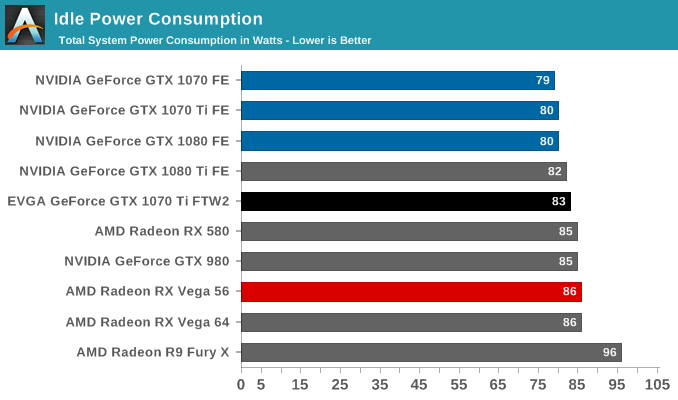
While the stated TDP remains 180W, the GTX 1070 FTW2 does possess two 8-pin PCIe power connectors over the Founders Edition’s single 6-pin. Considering the default 100% power limit, this extra power draw capacity can hardly be used in most applications, and for Battlefield 1 system consumption only ends up around 8W higher. But a power virus like FurMark has much less qualms about taking as much as it can, with the GTX 1070 Ti FTW2 immediately pulling a little extra, in the region of 30W at the wall.
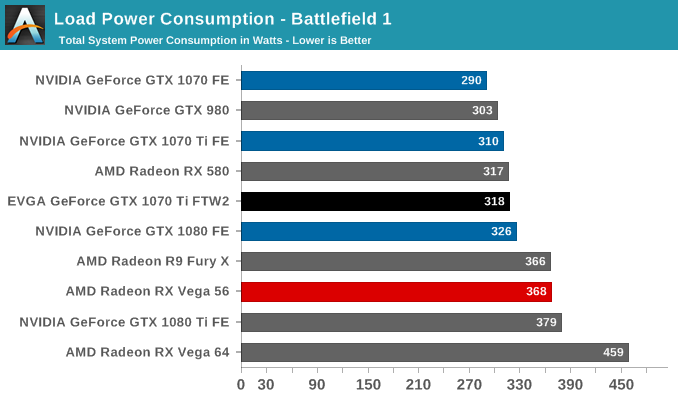
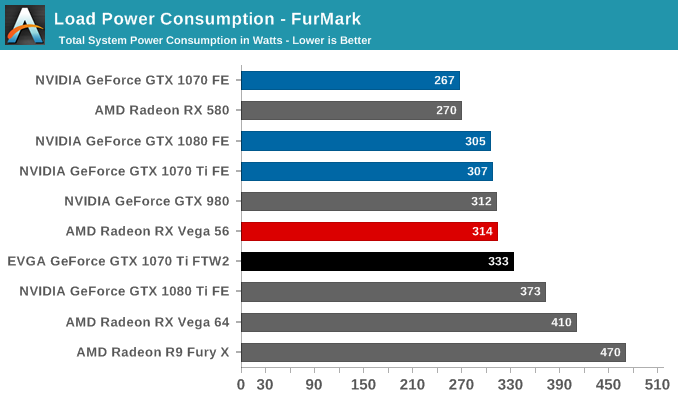
Like most high quality custom boards, the GTX 1070 Ti FTW2 can maintain a typical idling temperature with passive cooling. Under load, the fans kick in and the card settles just below its default 72 degree throttle point, even while running FurMark.
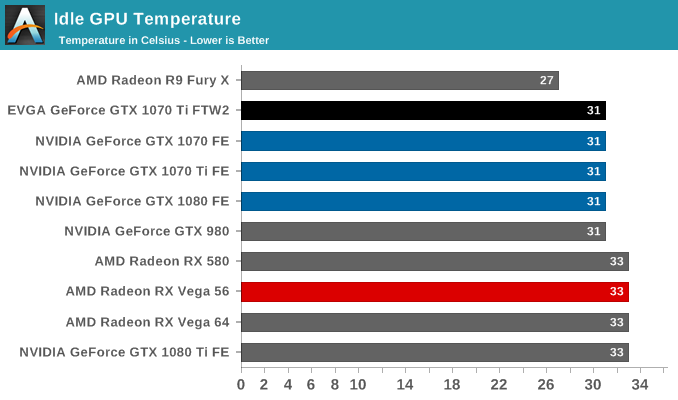
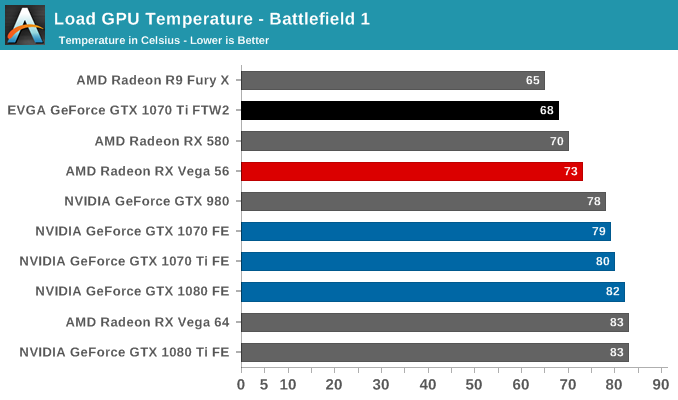
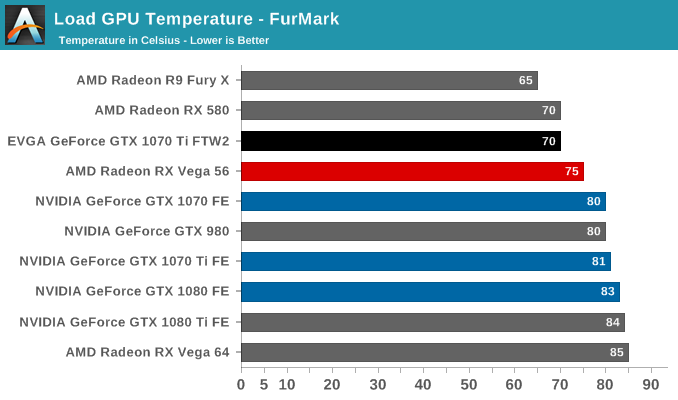
| EVGA GTX 1070 Ti FTW2 iCX Readings | |||
| Battlefield 1 (1440p) | FurMark | ||
| GPU Temperature | 68°C | 70°C | |
| iCX GPU2 Temp. | 65°C | 70°C | |
| iCX MEM1 Temp. | 50°C | 53°C | |
| iCX MEM2 Temp. | 59°C | 64°C | |
| iCX MEM3 Temp. | 70°C | 78°C | |
| iCX PWR1 Temp. | 65°C | 70°C | |
| iCX PWR2 Temp. | 66°C | 72°C | |
| iCX PWR3 Temp. | 66°C | 72°C | |
| iCX PWR4 Temp. | 66°C | 72°C | |
| iCX PWR5 Temp. | 68°C | 75°C | |
| Left Fan Speed (GPU) | 962 RPM | 1191 RPM | |
| Right Fan Speed (PWM/MEM) | 1066 RPM | 1320 RPM | |
At idle, of course, the graphics card utilizes zero fan speed idle. Under load, the cooling design proves capable enough with the fans at a relatively low speed, resulting in a rather quiet profile. Both fans ramp up asynchronously, and both unsurprisingly ramp up higher in FurMark, which features higher temperatures across all the iCX sensors. The general idea behind asynchronous fans can be seen in how the right fan speeds up in response to higher memory and PWM temperatures.
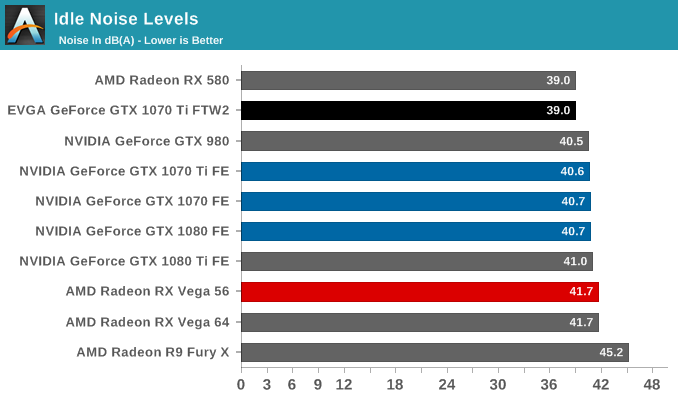
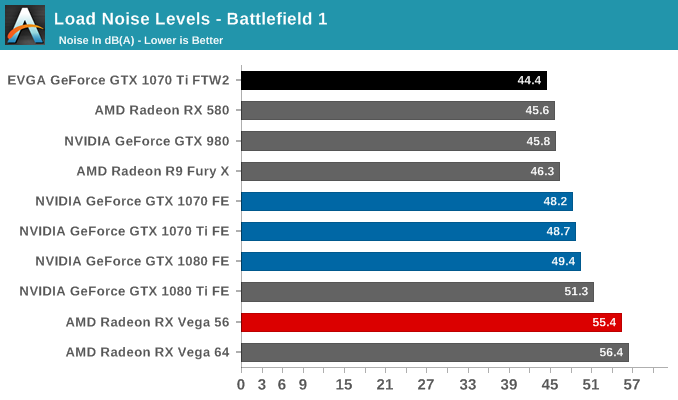
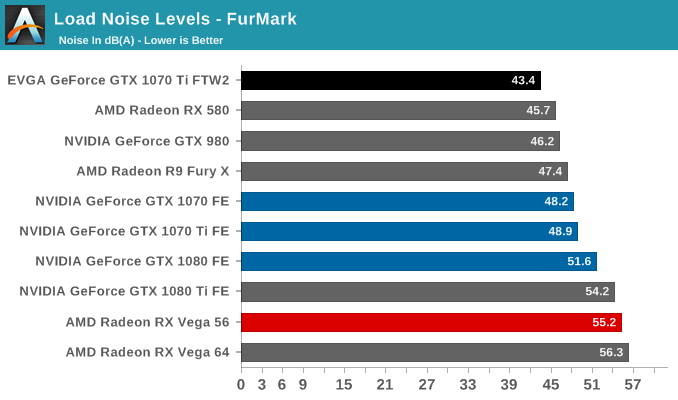
This kind of power, temperature, and noise profile will suit some just fine: a quiet card with purposeful temperature LEDs, all without user intervention. Others will immediately notice the unutilized headroom. With XOC Scanner, EVGA looks to court the former by with a single-step automatically applied overclock. And on that note, we move on to the overclocking…










47 Comments
View All Comments
Dr. Swag - Wednesday, January 31, 2018 - link
Oh cool! Anandtech finally reviews some aftermarket gpus!If only we could actually, you know, buy them.
sharath.naik - Wednesday, January 31, 2018 - link
Whats with the gpu prices?!! I had bought 1080 ti for 660$ 8 months back, today its 1400$+, when trying to get a second one.Hereiam2005 - Wednesday, January 31, 2018 - link
I bought mine last week for 750$. Its a shitty 1080ti, the gigabyte gaming oc version, but it is much cheaper than other models.Dr. Swag - Wednesday, January 31, 2018 - link
Miners.JoeyJoJo123 - Wednesday, January 31, 2018 - link
Supply/Demand.People are pointing the finger at miners, but it's more than just an alternative coin mining issue. AIB partners are hesitant to make more cards because the last time GPU mining was big, GPU AIBs mostly sought to meet bigger supply to the bigger demand, only to get burned three-ways.
1) Bitcoin market crashed. This led to GPU demand faltering quickly.
2) They had already made their quarterly order to AMD/nVidia and were stuck with excess GPUs which they couldn't sell due to:
a) Miner card resale market providing cheaper cards to those at lower price brackets.
b) Lack of miner demand which the increased supply was supposed to meet.
c) New GPU architecture releasing the next quarter, while they were still stuck on lots of old GPUs.
3) Excess of warranty claims for excess GPU supply to miners.
AIB partners would be willing to increase their quarterly orders so as to increase GPU supply to meet increased demand (due to miners) if they could _assume_ stability in the demand, which fundamentally means assuming stability in the crypto market, but stability in the crypto market is a complete and utter joke, so they're not willing to increase supply especially if next-gen GPUs might be around the corner if AMD/nVidia have an announcement by next quarter (GTX1100 series, RX600 series, etc.)
JoeyJoJo123 - Wednesday, January 31, 2018 - link
Also, GPU pricing is also being affected by 3rd party sellers wanting to take advantage of the mining demand. 3rd party marketplace sellers on Amazon marketplace, Newegg marketplace, and eBay are also scalping excess GPU stock not to mine, but just to resell to gamers willing to fork over the money, but particularly to miners which can still recoup on the purchase, but will face a longer return on investment.Don't buy from 3rd party marketplace scalpers, they're just as guilty as miners (if not moreso, as they have no intent to even open the GPUs to use them for themselves) for draining supply from 1st party sellers, which prevents folk like you from getting rational prices.
Just wait for next gen cards, maybe. AIBs won't be shy to ramp up production of the newest stuff that miners and gamers will be sure to buy and can guarantee they won't be sitting on outdated stock.
Pinn - Wednesday, January 31, 2018 - link
Nvidia has volta, but AMD has nothing next-gen for awhile.VulkanMan - Wednesday, January 31, 2018 - link
AMD has Navi.CiccioB - Thursday, February 1, 2018 - link
Coming in 2019FreckledTrout - Wednesday, February 7, 2018 - link
AMD have Vega on 7nm coming this year. I wouldn't brush the move to 7nm off either is it should allow the GCN architecture to breath by hitting much higher clocks. Of course the proof is in the pudding but I expect the 7nm shrink to be a decent performance bump.